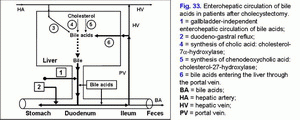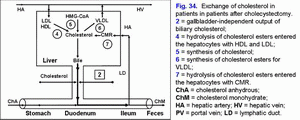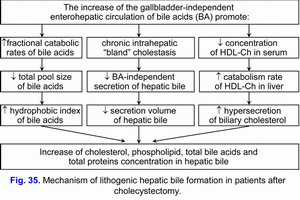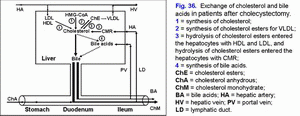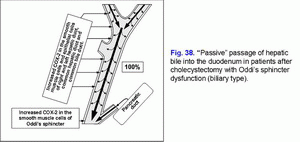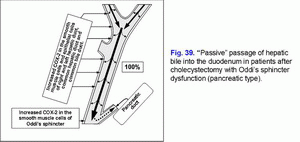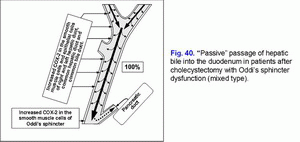
Русский | English
Postcholecystectomy Syndrome, or Condition after Cholecystectomy (Gallbladder Removal) |
The laparoscopic cholecystectomy is considered the “gold standard” in chronic calculous cholecystitis treatment. After the gallbladder removal the physiology of gallbladder bile formation is changed. Absence of the gallbladder leads to development of functional biliary hypertension and dilatation of common bile duct and the common hepatic duct (1-8). The dilatation of right and left hepatic ducts may be formed within 3-5 years after cholecystectomy (1-8). Functional hypertension in the common bile duct leads to development of functional hypertension in Wirsung's pancreatic duct accompanied by chronic pancreatitis symptoms (1-8). During this period in some patients this is accompanied by chronic pancreatitis progression, dysfunction of the sphincter of Oddi and duodeno-gastral reflux (1-17). Duodeno-gastral reflux causes the development of atrophic (bile-acid-dependent) antral gastritis (1-11). After cholecystectomy 40% to 60% of patients suffer from dyspeptic disorders, 5% to 40% from pains of different localizations (1-17). Up to 70% of patients show symptoms of chronic “bland” intrahepatic cholestasis, chronic cholestatic hepatitis and compensatory bile-acid-dependent apoptosis of hepatocytes (11-15). In some of cholecystectomized patients with high concentration of hydrophobic hepatotoxic co-cancerogenic deoxycholic bile acid in serum and/or feces high risk of the colon cancer is found. Therefore, depending on dysfunction (hyper tonus) or relaxation (hypo tonus) of the sphincter of Oddi, pathology in hepato-biliary-pancreato-duodenal-gastral zone will form after cholecystectomy. Postcholecystectomy syndrome is a dysfunction of the sphincter of Oddi, caused by noncalculous obstructive disorder, which decrease bile passage and pancreatic juice outflow into the duodenum (1-2). Diagnostic criteria of the sphincter Oddi dysfunction
Pain may be accompanied by the following symptoms:
Causes of the biliary pain and chronic inflammation in the biliary tract and the sphincter of Oddi
Mechanism of development of pathologic disordersAbsence of the gallbladder leads to surplus passage of hepatic bile only into the duodenum and increases frequency of gallbladder-independent enterohepatic circulation of bile acids. There is only gallbladder-independent enterohepatic circulation of bile acids in patients after cholecystectomy (fig. 33). Absence of the gallbladder after cholecystectomy causes the increase in passage of hepatic bile into the duodenum and the gallbladder-independent enterohepatic circulation of biliary cholesterol and bilirubin (fig. 34). Increase in gallbladder-independent enterohepatic circulation of bile acids causes increase in concentration of bile acids in the hepatocytes and decrease in the accumulation function and excretion function of the liver (i.e. formation of chronic “bland” intrahepatic cholestasis) (fig. 33). Increase in the gallbladder-independent enterohepatic circulation of biliary cholesterol helps in increase of absorption of biliary cholesterol in the small intestine, the biliary cholesterol entering hepatocytes, and hypersecretion into hepatic bile (fig. 34). This factor contributes to the formation of the “lithogenic” hepatic bile and predisposes to choledocholithiasis (formation of gallstones in bile ducts) (fig. 35). Increase in the gallbladder-dependent output of biliary cholesterol and in the concentration of total bile acids in duodenal bile cause causes the precipitation of cholesterol monohydrate crystals in the duodenum lumen in postcholecystectomic patients (fig. 36). Due to the sphincter of Oddi incompetence surplus hepatic bile passage into the duodenum causes formation of duodeno-gastral reflux and development of chronic atrophic (bile-acid-dependent) antral gastritis, often accompanied by intestinal metaplasia, and gastroduodenitis (fig. 33, fig. 37). Due to dysfunction of the sphincter of Oddi (high degree of COX-2 expression in the smooth muscle and epithelial cells of the sphincter of Oddi), hindered passage of hepatic bile into the duodenum causes development of the functional biliary hypertension, dilating of the common hepatic duct and common bile duct, development of the biliary pain in epigastrium or right hypochondrium (high degree of COX-2 expression in the smooth muscle and epithelial cells of the biliary tract), and chronic “bland” intrahepatic cholestasis and/or reactive hepatitis (fig. 38). In some postcholecystectomic patients who have the sphincter of Oddi dysfunction (high degree of COX-2 expression in the smooth muscle and epithelial cells of the sphincter of Oddi), hindered passage of hepatic bile into the duodenum causes development of the functional biliary hypertension in the common bile duct, the functional hypertension in the Wirsung’s duct, the pain syndrome in the left hypochondrium, and the symptoms of chronic biliary pancreatitis (pancreatic type) (fig. 39). Due to dysfunction of the sphincter of Oddi (high degree of COX-2 expression in the smooth muscle and epithelial cells of the sphincter of Oddi), hindered passage of hepatic bile into the duodenum causes development of the functional biliary hypertension dilating of the common hepatic duct and common bile duct, development of the biliary pain in epigastrium or right hypochondrium (high degree of COX-2 expression in the smooth muscle and epithelial cells of the biliary tract), chronic “bland” intrahepatic cholestasis and/or reactive hepatitis, the functional hypertension in the Wirsung’s duct, the pain syndrome in the left hypochondrium, and the symptoms of chronic biliary pancreatitis (combined type) (fig. 40).
Pathogenetic treatment of patients after cholecystectomyAccordingly, treatment for patients after cholecystectomy (Postcholecystectomy syndrome is a dysfunction or incompetence of the sphincter of Oddi) (with biliary pain), aiming for the prophylactics of choledocholithiasis, duodeno-gastral reflux, antral atrophic (bile-acid-dependent) gastritis and chronic biliary pancreatitis includes
Celebrex (Celecoxib) is a selective inhibitor of COX-2. Inhibiting COX-2 activity in the smooth muscle cells of the biliary tract and the sphincter of Oddi it brings relief of the biliary pain within 3-5 days, restoration of the passage of the hepatic bile into the duodenum. Celebrex (Celecoxib) is a selective inhibitor of COX-2, inhibiting COX-2 activity in the epithelial cells of the biliary tract mucosa causes decrease in secretion of glycoprotein mucin into the biliary tract lumen, concentration of the glycoprotein biliary mucin in the hepatic bile and viscosity of hepatic bile, which prevents formation of biliary sludge and gallstones in the common hepatic duct and common bile duct. Low COX-2 activity in the epithelial cells and the smooth muscle cells of the biliary tract helps in lowering the risk of choledocholithiasis development. Ursofalk (ursodeoxycholic acid), is a hydrophilic hepatoprotective bile acid. It helps in dissolving the cholesterol monohydrate crystals in the biliary tract, decrease in lithogenicity of hepatic bile, disappearance of the chronic “bland” intrahepatic cholestasis (i.e. results in the restoration of the accumulation and excretion functions of liver), and in some patients helps in dissolving the biliary sludge in the biliary tract. Ursofalk (ursodeoxycholic acid), is a hydrophilic hepatoprotective bile acid, decreasing aggressive properties of bile, prevents development of duodeno-gastral reflux and chronic atrophic (bile-acid-dependent) antral gastritis, often accompanied by intestinal metaplasia, and gastroduodenitis. Celebrex (Celecoxib) and Ursofalk (ursodeoxycholic acid), pathogenetically blocking main mechanisms of gallstone formation, help in prophylactics of gallstone formation in the biliary tract, and lower the risk of development of choledocholithiasis and chronic biliary pancreatitis. Expected effectiveness is 90-95%.
Attention!!! Information for patients: Before using this scheme of treatment please check the contraindications (below) and side effects of using pharmacological preparations of Celebrex (Celecoxib) and Ursofalk (ursodeoxycholic acid), and obtain your doctor’s permission. Contraindications for Celebrex (Celecoxib):
Contraindications for Ursofalk (ursodeoxycholic acid):
This web page does not bear any legal responsibility for the use of the proposed treatment schemes without consulting your doctor. References:
|
|
|
